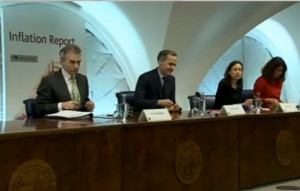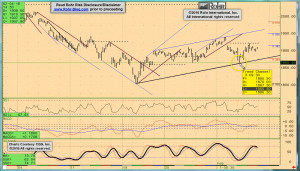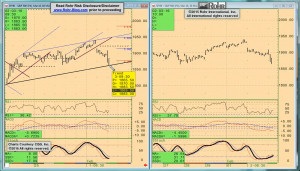2016/02/05 Commentary: FOMC – MPC Battle?
© 2016 ROHR International, Inc. All International rights reserved.
Extended Trend Assessments reserved for Gold and Platinum Subscribers
COMMENTARY (Non-Video): Friday, February 5, 2016
Commentary: FOMC – MPC Battle?
 Let’s allow from the outset that this is not a UFC (Ultimate Fighting Championship) cage match. There won’t be a knockout decision that leaves one contender victorious and the other vanquished. However, insofar as it is possible either the US Federal Open Market Committee or the Bank of England's Monetary Policy Committee could end up bloodied once this difference of opinion on the impact of a weaker global economic situation is resolved. It is especially interesting that the equities are weakening after this morning's US Employment report indicated weaker than expected growth in Non-Farm Payrolls. Within the current ‘bad news is good news’ equities psychology based on more accommodative central banks (BoE included), 40,000 fewer than estimated US jobs created in January might have been bullish.
Let’s allow from the outset that this is not a UFC (Ultimate Fighting Championship) cage match. There won’t be a knockout decision that leaves one contender victorious and the other vanquished. However, insofar as it is possible either the US Federal Open Market Committee or the Bank of England's Monetary Policy Committee could end up bloodied once this difference of opinion on the impact of a weaker global economic situation is resolved. It is especially interesting that the equities are weakening after this morning's US Employment report indicated weaker than expected growth in Non-Farm Payrolls. Within the current ‘bad news is good news’ equities psychology based on more accommodative central banks (BoE included), 40,000 fewer than estimated US jobs created in January might have been bullish.
However, two other key components of the overall US jobs report are considered to be a major reinforcement for the Fed's tightening stance. While recent weak economic data seem to fly in the face of that tightening instinct, this morning’s better-than-expected Hourly Earnings along with the Unemployment Rate dropping to 4.90% (lowest since February 2008) seems to have at least partially reinforced the FOMC's perspective.
That said, the US Bureau of Labor Statistics of the Labor Department always applies a significant ‘seasonal adjustment’ to these numbers. That leaves room for major revisions like last month's downgrading of the headline jobs number from a gain of 292,000 down to 262,000; and it could drop further on the final revision next month. Yet for now, higher long-term government bond yields coming along with the weakness of equities today would seem to speak of real-time concerns about the Fed's future actions. All of which is not just contrary to the Bank of England's view, but also the far more accommodative perspective assumed lately by the ECB and Bank of Japan.
So in the context of the significant weakness in much of the rest of the world, which perspective is going to dominate?
Authorized Silver and Sterling Subscribers click ‘Read more…’ (below) to access the balance of the opening discussion. Non-subscribers click the top menu Subscription Echelons & Fees tab to review your options and join us. Authorized Gold and Platinum Subscribers click ‘Read more…’ (below) to also access the Extended Trend Assessment as well.





2016/02/05 TrendView VIDEO: Foreign Exchange (weekend)
2016/02/05 TrendView VIDEO: Foreign Exchange (weekend)
© 2016 ROHR International, Inc. All International rights reserved.
The analysis videos are reserved for Gold and Platinum Subscribers
TrendView VIDEO ANALYSIS & OUTLOOK: Friday, February 5, 2016 (weekend)
While not quite as wild and wooly as the equities previous, foreign exchange has had its own very aggressive movements of late. And it is more than just select individual currencies, as the serial psychological shifts affected various currencies across the course of the past several weeks; and especially last week. While the other developed economy and emerging currencies had swirled around each other previous, the impact of the Fed’s ‘normalcy bias’ (see our December 16th afternoon post on that) finally came home to weigh heavily on the US Dollar Index from the middle of last week. There is more on that below and in the video discussion. Suffice to say for now that one of our favorite (even if not very short-term trend influential) indications is back on Monday morning:
The next set of Organization for Economic Cooperation and Development (OECD) Composite Leading Indicators (CLI.) As we have noted previous, the titles of monthly updates attempt to be upbeat no matter what the actual data may show. Yet even a cursory review of the actual graphs of the future economic indications in January’s OECD CLI release shows real weakness. The US is clearly in a cyclical downturn since as far back as late 2014, and weakening further at present. The same is true for the UK along with Japan. Of course China is still weak, and commodity economies like Canada and Russia are commensurately still suffering, even if India and Brazil might be bottoming.
While the Euro-zone seems to be recovering, that is not of much comfort for two reasons. The Euro-zone is starting from a very low base on both economic growth and inflation, and the recent data has not been very inspiring. And in any event, we have the same question as previous on that: With so many other major economies weakening, are we really going to rely upon Europe to lead the way higher?
_____________________________________________________________
Video Timeline: It begins with little on the macro (i.e. fundamental influences) other than to mention the return to weaker data overall that was highlighted by the Bank of England holding the base rate steady at the 0.50% all-time low Thursday and the Fed’s Dudley finally questioning whether the Fed is right to be raising rates at this time. The rest will be covered in the Special Weekend TrendView video on equities and fixed income.
It moves on to the US DOLLAR INDEX at 02:00, EUR/USD at 06:15, GBP/USD at 10:45, AUD/USD at 13:45 and USD/JPY at 16:00 followed by the very active CROSS RATES at 20:15 to prior returning to the US DOLLAR INDEX at 24:45 to complete the full review.
_____________________________________________________________
Authorized Gold and Platinum Subscribers click ‘Read more…’ (below) to access the balance of the opening discussion and TrendView Video Analysis and General Update. Silver and Sterling Subscribers click ‘Read more…’ (below) to access the balance of the opening discussion.
Read more...